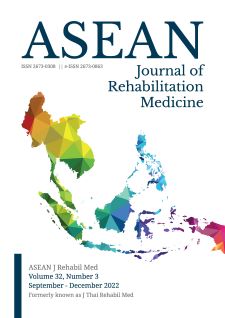Rate and Outcomes of Re-Admission for Rehabilitation in the Thai Red Cross Rehabilitation Center: A Retrospective Study
Keywords:
rehabilitation, inpatient, re-admission, functional outcomes, ambulationAbstract
Objectives: To study the rate of re-admission and functional outcomes in re-admitted patients of the Thai Red Cross Rehabilitation Center during the period 2015-2019.
Study design: Retrospective study.
Setting: The Thai Red Cross Rehabilitation Center, Samut Prakan Province, Thailand..
Subjects: All admitted patients who were re-admitted during the period 2015-2019. Pediatric patients and Thai Red Cross Patrons admitted primarily to provide relief of the burden on caregivers were excluded from the functional outcome analysis.
Methods: Rates of re-admission were calculated from all admitted and re-admitted patients during the study period. After excluding pediatric patients and Thai Red Cross patrons, medical records of the remaining patients were extracted and their demographic characteristics, clinical data and functional outcomes from the first and the last admissions were reviewed and analyzed.
Results: During the study period, 1,438 patients were admitted of whom 460 patients (32.0%) were later re-admitted. After excluding 271 patients who did not meet the study criteria, 48.2% of the remaining 189 patients had been re-admitted only once. The most common diagnosis at initial admission was stroke (48.2%). Both duration from onset to the last re-admission and diagnostic categories were significantly associated with the number of re-admissions (p < 0.001). At the last re-admission, some patients showed improvement in ambulation (29.1%), in disability level based on the modified Barthel Index (23.8%), in dynamic sitting balance (16.9%) and in static sitting balance (15.3%).
Conclusion: The re-admission rate at the Thai Red Cross Rehabilitation Center during the 2015-2019 period was 32.0%. Stroke patients had the highest rate of re-admission. At the last rehabilitation re-admission, some patients had gained functional improvement and nearly 30% had improvement in ambulation.
References
Gómara-Toldrà N, Sliwinski M, Dijkers MP. Physical therapy after spinal cord injury: a systematic review of treatments focused on participation. J Spinal Cord Med. 2014;37:371-9.
Greysen SR, Stijacic Cenzer I, Auerbach AD, Covinsky KE. Functional impairment and hospital re-admission in medicare seniors. JAMA Intern Med. 2015;175:559-65.
Zhong W, Geng N, Wang P, Li Z, Cao L. Prevalence, causes and risk factors of hospital re-admissions after acute stroke and transient ischemic attack: a systematic review and meta-analysis. Neurol Sci. 2016;37:1195-202.
McKechnie D, Fisher MJ, Pryor J, McKechnie R. Predictors of unplanned re-admission to acute care from inpatient brain injury rehabilitation. J Clin Nurs. 2020;29:593-601.
Mashola MK, Olorunju SAS, Mothabeng J. Factors related to hospital re-admissions in people with spinal cord injury in South Africa. S Afr Med J. 2019;109:107-11.
The Thai Red Cross Society [Internet]. Bangkok. Vision - Mission - Strategy. 2021. [cited 2021 Sep 30]. Available from https://english.redcross.or.th/aboutus/vision/
Murray E. Stroke rehabilitation. In: Delisa JA, Gans BM, editors. Rehabilitation medicine principle and practice. 3rd ed. New York: Lippincott-Raven, 1998; p. 1176.
Miller EL, Murray L, Richards L, Zorowitz RD, Bakas T, Clark P, Billinger SA. American Heart Association Council on Cardiovascular Nursing and the Stroke Council. Comprehensive overview of nursing and interdisciplinary rehabilitation care of the stroke patient: a scientific statement from the American Heart Association. Stroke. 2010;41:2402-48.
Kuptniratsaikul V, Kovindha A, Massakulpan P, Piravej K, Suethanapornkul S, Dajpratham P, et al. An epidemiologic study of the Thai Stroke Rehabilitation Registry (TSRR): a multi-center study. J Med Assoc Thai. 2008;91:225-33.
O’Sullivan SB, Schmitz TJ. Physical rehabilitation: assessment and treatment. 5th ed. Philadelphia: F. A. Davis; 2007. p. 254.
Wade DT, Hewer RL. Functional abilities after stroke: measurement, natural history and prognosis. J Neurol Neurosurg Psychiatry. 1987;50:177-82.
Mehrholz J, Wagner K, Rutte K, Meissner D, Pohl M. Predictive validity and responsiveness of the functional ambulation category in hemiparetic patients after stroke. Arch Phys Med Rehabil. 2007; 88:1314-9.
Kuptniratsaikul V, Thitisakulchai P, Sarika S Khaewnaree S. The burden of stroke on caregivers at 1-year period: a multicenter study. J Thai Rehabil Med. 2018;28:8-14.
Kuptniratsaikul V, Wattanapa P, Wathanadilokul U, Sukonthamarn K, Lukkanapichonchut P, Ingkasuthi K, et al. The effectiveness and efficiency of inpatient rehabilitation services in Thailand: a prospective multicenter study. Rehabil Process Outcome. 2016;5: 13-8.
Ottenbacher KJ, Smith PM, Illig SB, Fiedler RC, Gonzales V, Granger CV. Characteristics of persons rehospitalized after stroke rehabilitation. Arch Phys Med Rehabil. 2001;82:1367-74.
Claesson L, Gosman-Hedström G, Fagerberg B, Blomstrand C. Hospital re-admissions in relation to acute stroke unit care versus conventional care in elderly patients the first year after stroke: the Göteborg 70+ stroke study. Age Ageing. 2003;32:109-13.
Benbassat J, Taragin M. Hospital re-admissions as a measure of quality of health care: advantages and limitations. Arch Intern Med. 2000;160:1074- 81.
Bohannon RW, Lee N. Association of physical functioning with same-hospital re-admission after stroke. Am J Phys Med Rehabil. 2004;83:434- 8.
Kuptniratsaikul V, Kovindha A, Massakulpan P, Permsirivanich W, Kuptniratsaikul PS. Inpatient rehabilitation services for patients after stroke in Thailand: a multi-centre study. J Rehabil Med. 2009; 41:684- 6.
Watanabe TK, Esquenazi A, Flanagan S. The Transformation of the rehabilitation paradigm across the continuum of care. PM R. 2018;10:264- 71.
Kuptniratsaikul V, Kovindha A, Piravej K, Dajpratham P. First-year outcomes after stroke rehabilitation: a multicenter study in Thailand. ISRN Rehabil. 2013;2013:1- 6. doi: 10.1155/2013/595318.
Tay MRJ. Hospital re-admission in stroke survivors one year versus three years after discharge from inpatient rehabilitation: Prevalence and associations in an Asian cohort. J Rehabil Med. 2021; 53: jrm00208. doi: 10.2340/16501977-2849.
Downloads
Published
How to Cite
Issue
Section
License

This work is licensed under a Creative Commons Attribution-NonCommercial-NoDerivatives 4.0 International License.






